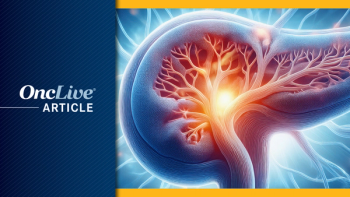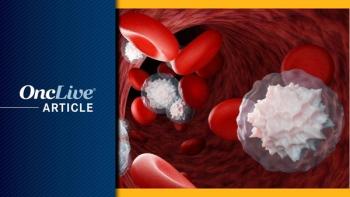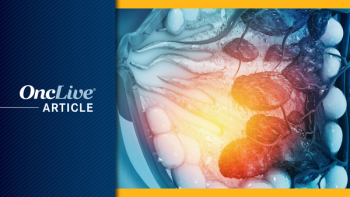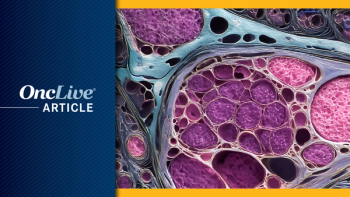
Clinical Activity With High-dose HPN217 Warrants Continued Research in R/R Multiple Myeloma
Al-Ola A. Abdallah, MD, discusses updated safety and efficacy data with HPN217 in relapsed/refractory multiple myeloma and next steps for the investigation as well as sequencing of BCMA-targeted therapies for this patient population.
The novel B-cell maturation antigen (BCMA)-targeting T-cell engager HPN217 showed deep and durable responses with a well-tolerated safety profile in patients with heavily pretreated, relapsed/refractory multiple myeloma. According to Al-Ola A. Abdallah, MD, these data position the agent as a candidate for the treatment armamentarium and support its clinical development through continuing dose optimization.
Updated interim results from an ongoing phase 1 trial (NCT04184050) of HPN217 in patients with relapsed/refractory multiple myeloma who have received at least 3 prior therapies were presented at the 2022 ASH Annual Meeting and Exposition.1 A step-dosing regimen of HPN217 produced an overall response rate (ORR) of 77% in patients receiving higher doses at 12 mg or 24 mg, and the median overall responder time on treatment was 7 months. Three patients who were evaluated for minimal residual disease (MRD) were found to be MRD negative.2
Tolerability of HPN217 was maintained with the step-up dosing regimen. Grade 1 and 2 cytokine release syndrome (CRS) was observed in 29% of patients and in primarily early doses. Moreover, CRS did not increase at the higher dose levels, and no immune effector cell associated neurotoxicity syndrome (ICANS) events were recorded.2
“Our biggest focus [with] BCMA-targeted therapy has to be [increasing] tolerability and efficacy for patients,” Abdallah, an associate professor and physician at University of Kansas Medical Center, said in an interview with OncLive®. “... [With continued dose-escalation], we're hoping to see a continuous improvement in efficacy and toxicity results.”
In the interview, Abdallah expanded on the rationale for and design of the phase 1 study, detailed updated safety and efficacy data with HPN217 in relapsed/refractory multiple myeloma, and discussed next steps for the investigation as well as sequencing of BCMA-targeted therapies for this patient population.
OncLive®: What was the rationale for investigating HPN217 in this phase 1 study?
Abdallah: The goal of this phase 1, multicenter, open-label study [was] to focus on the safety, tolerability, pharmacokinetics, and efficacy of this treatment. [We] mainly focused on patients [with] relapsed/refractory multiple myeloma who got at least 3 [prior] lines of therapy and
were known [to be] triple exposed to 3 different classes of therapies. [These] include immunomodulatory drugs, proteasome inhibitors, and CD38 monoclonal antibodies.
How is the mechanism of action for HPN217 unique?
HPN217 is a trispecific T-cell activating construct, or TriTAC, which attaches to 3 different domains. One [arm] attaches to the BCMA, which is present in 95% of plasma cells; that helps [the agent] target myeloma cells. The second [domain] is CD3, which is [found] on T cells. The third domain is the [human serum] albumin, [which] extends the half-life for the TriTAC. The attachment of [HPN217] to BCMA and CD3 [helps] the immune system [attack] tumors.
Please describe the trial design.
The first part [of the study] was a fixed-dose [schedule]. Patients received a small dose [of HPN217] to evaluate the treatment's tolerability and efficacy. The second part increased the dosage [from] 2.15 mg up to 2.86 mg using step-up dosing. If [patients] tolerated that [dosage, investigators] increased the second dose up to 12 mg and 24 mg, [which] was the target dose.
What were the key efficacy data with HPN217?
The efficacy [analysis was] mainly focused [on] patients who got the higher dose [of] 12 mg to 24 mg. These patients [had] a response rate [of] 77%, and 46% of these patients [had a] very good partial response or better. Median follow-up for patients who stayed on the treatment [was] 9 months. We saw a deeper and longer duration of response up to 12 months, and we think that [DOR] is [still] going to improve [as] we enroll and follow-up [with] more patients. [These data are] typical for BCMA-targeted therapy.
What should be taken away from the analysis from a safety perspective?
For the safety [analysis], we looked at hematological and non-hematological [adverse effects (AEs)]. Anemia, fatigue, and CRS were common AEs in patients who got HPN217. Patients who [received] the step-up dosing [had a] CRS [rate] of 29%, which is low compared [with] bispecific antibodies. All patients had grade 1 and 2 [CRS], and the percentage of patients who got tocilizumab [Actemra] was 6%.
We did not see AEs like neurological toxicity, [ICANS], and all other abnormal neurological movements in these patients. The infection rate was 45%, [which included] pneumonia, upper
respiratory infection, and urinary tract infection. [These] safety issues [are] commonly seen [with] BCMA-targeted therapies and were expected.
What are the next steps for this early research?
The next step here is to continue enrollment of patients who are triple-exposed, and [had] prior BCMA-targeted therapy, and [use] a 12- and 24-mg dosage schedule. We believe [that administration] of this treatment is going to change to every other week [because] there's a longer half-life. We [hope to see] lower AEs for these patients.
Where should future research efforts be focused in relapsed/refractory multiple myeloma?
Our biggest focus [with] BCMA-targeted therapy has to be [increasing] tolerability and efficacy for patients. We have 3 different BCMA-targeted therapies that have been FDA approved, and we have to assume that many of patients are going to receive [them in the course of treatment]. We [need to improve] sequencing [of] these newer treatments, including HPN217, [for] patients who [who progressed] on prior BCMA-targeted therapies.
References
- Abdallah AA, Cowan AJ, Leleu X, et al. Updated interim results from a phase 1 study of HPN217, a half-life extended tri-specific T cell activating construct (TriTAC®) targeting B cell maturation antigen (BCMA) for relapsed/refractory multiple myeloma (RRMM). Blood. 2022;140(suppl 1):7284-7285. doi:10.1182/blood-2022-159665
- Harpoon Therapeutics presents updated interim results at ASH 2022 for novel T-cell engager HPN217 in relapsed/refractory multiple myeloma. Harpoon Therapeutics. December 7, 2022. Accessed February 6th, 2023. https://ir.harpoontx.com/news-releases/news-release-details

























































































